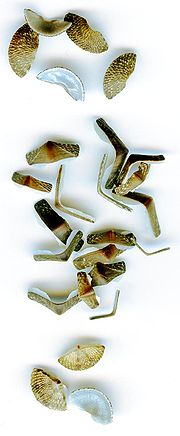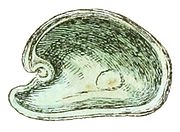
Valve (chiton)
Encyclopedia

Mollusc shell
The mollusc shell is typically a calcareous exoskeleton which encloses, supports and protects the soft parts of an animal in the phylum Mollusca, which includes snails, clams, tusk shells, and several other classes...
of molluscs
Mollusca
The Mollusca , common name molluscs or mollusksSpelled mollusks in the USA, see reasons given in Rosenberg's ; for the spelling mollusc see the reasons given by , is a large phylum of invertebrate animals. There are around 85,000 recognized extant species of molluscs. Mollusca is the largest...
. Although in theory any mollusc shell can be termed a "valve", the word is now most commonly applied to members of two classes
Class (biology)
In biological classification, class is* a taxonomic rank. Other well-known ranks are life, domain, kingdom, phylum, order, family, genus, and species, with class fitting between phylum and order...
of molluscs: the Bivalvia
Bivalvia
Bivalvia is a taxonomic class of marine and freshwater molluscs. This class includes clams, oysters, mussels, scallops, and many other families of molluscs that have two hinged shells...
(clams) and the Polyplacophora (chitons), in other words, to those molluscs whose shells are normally composed of more than one articulating part, each one of which is known as a valve (and also, in the case of chitons, as a "plate".)
Species within one family of very unusual small sea snail
Snail
Snail is a common name applied to most of the members of the molluscan class Gastropoda that have coiled shells in the adult stage. When the word is used in its most general sense, it includes sea snails, land snails and freshwater snails. The word snail without any qualifier is however more often...
s, marine
Marine (ocean)
Marine is an umbrella term. As an adjective it is usually applicable to things relating to the sea or ocean, such as marine biology, marine ecology and marine geology...
opisthobranch gastropods in the family Juliidae
Juliidae
Juliidae, common name the bivalved gastropods, is a family of minute sea snails, marine gastropod mollusks or micromollusks in the superfamily Oxynooidea, an opisthobranch group....
, also have two articulating shells or valves, which resemble those of a bivalve. This exceptional family is commonly known as the bivalved gastropods.
Gastropods in general are sometimes called "univalves", because in those that have a shell, the shell is usually in one part.
Chitons
The valves of chitonChiton
Chitons are small to large, primitive marine molluscs in the class Polyplacophora.There are 900 to 1,000 extant species of chitons in the class, which was formerly known as Amphineura....
s are eight dorsal
Dorsum (biology)
In anatomy, the dorsum is the upper side of animals that typically run, fly, or swim in a horizontal position, and the back side of animals that walk upright. In vertebrates the dorsum contains the backbone. The term dorsal refers to anatomical structures that are either situated toward or grow...
, articulated shell plates, which are frequently coloured and sculptured. After death the girdle that holds the plates together disintegrates and the plates separate. Thus individual plates can be found washed up in beach drift, as shown in the image at the top of this article.
Bivalves
Bivalve molluscaMollusca
The Mollusca , common name molluscs or mollusksSpelled mollusks in the USA, see reasons given in Rosenberg's ; for the spelling mollusc see the reasons given by , is a large phylum of invertebrate animals. There are around 85,000 recognized extant species of molluscs. Mollusca is the largest...
(clams) have a shell which is composed of two separate but articulating parts. Each one of these two parts is known as a "valve".
The two valves are known as the "right valve" and the "left valve"; these are labeled with respect to the anterior end of the bivalve, when the umbones are facing upward. In many, but not all, bivalves, the two valves are more or less symmetrical and thus (other than the hinge line) look like mirror image
Mirror image
A mirror image is a reflected duplication of an object that appears identical but reversed. As an optical effect it results from reflection off of substances such as a mirror or water. It is also a concept in geometry and can be used as a conceptualization process for 3-D structures...
s of one another.
Bivalved gastropods

Snail
Snail is a common name applied to most of the members of the molluscan class Gastropoda that have coiled shells in the adult stage. When the word is used in its most general sense, it includes sea snails, land snails and freshwater snails. The word snail without any qualifier is however more often...
s have a shell in one part, hence the older name "univalve". The gastropod operculum
Operculum (gastropod)
The operculum, meaning little lid, is a corneous or calcareous anatomical structure which exists in many groups of sea snails and freshwater snails, and also in a few groups of land snails...
, when present, even when it is composed mostly of calcium carbonate
Calcium carbonate
Calcium carbonate is a chemical compound with the formula CaCO3. It is a common substance found in rocks in all parts of the world, and is the main component of shells of marine organisms, snails, coal balls, pearls, and eggshells. Calcium carbonate is the active ingredient in agricultural lime,...
, is not considered to be a valve.
In contrast, species within one family of small sea snail
Snail
Snail is a common name applied to most of the members of the molluscan class Gastropoda that have coiled shells in the adult stage. When the word is used in its most general sense, it includes sea snails, land snails and freshwater snails. The word snail without any qualifier is however more often...
s, the Juliidae
Juliidae
Juliidae, common name the bivalved gastropods, is a family of minute sea snails, marine gastropod mollusks or micromollusks in the superfamily Oxynooidea, an opisthobranch group....
, opisthobranch gastropod molluscs, have a hinged shell
Gastropod shell
The gastropod shell is a shell which is part of the body of a gastropod or snail, one kind of mollusc. The gastropod shell is an external skeleton or exoskeleton, which serves not only for muscle attachment, but also for protection from predators and from mechanical damage...
which is composed of two parts joined by a ligament. These two parts very closely resemble the two valves of a bivalve. This group of species are often referred to as "bivalved gastropods". These are Sacoglossa
Sacoglossa
Sacoglossa, commonly known as the sacoglossans or the "sap-sucking sea slugs", are a clade of small sea slugs and sea snails, marine gastropod mollusks that belong to the clade Heterobranchia...
ns in several genera such as Julia, Berthelinia, Midorigai, Edenttellina, Tamanovalva, Candinida, etc.
These bivalve gastropods were for a long time known only from fossils and dead material. Because of this, they had been described as being somewhat atypical bivalves. It was not until living individuals were found in the late 20th century that it was understood that they are in fact very unusual gastropods.

